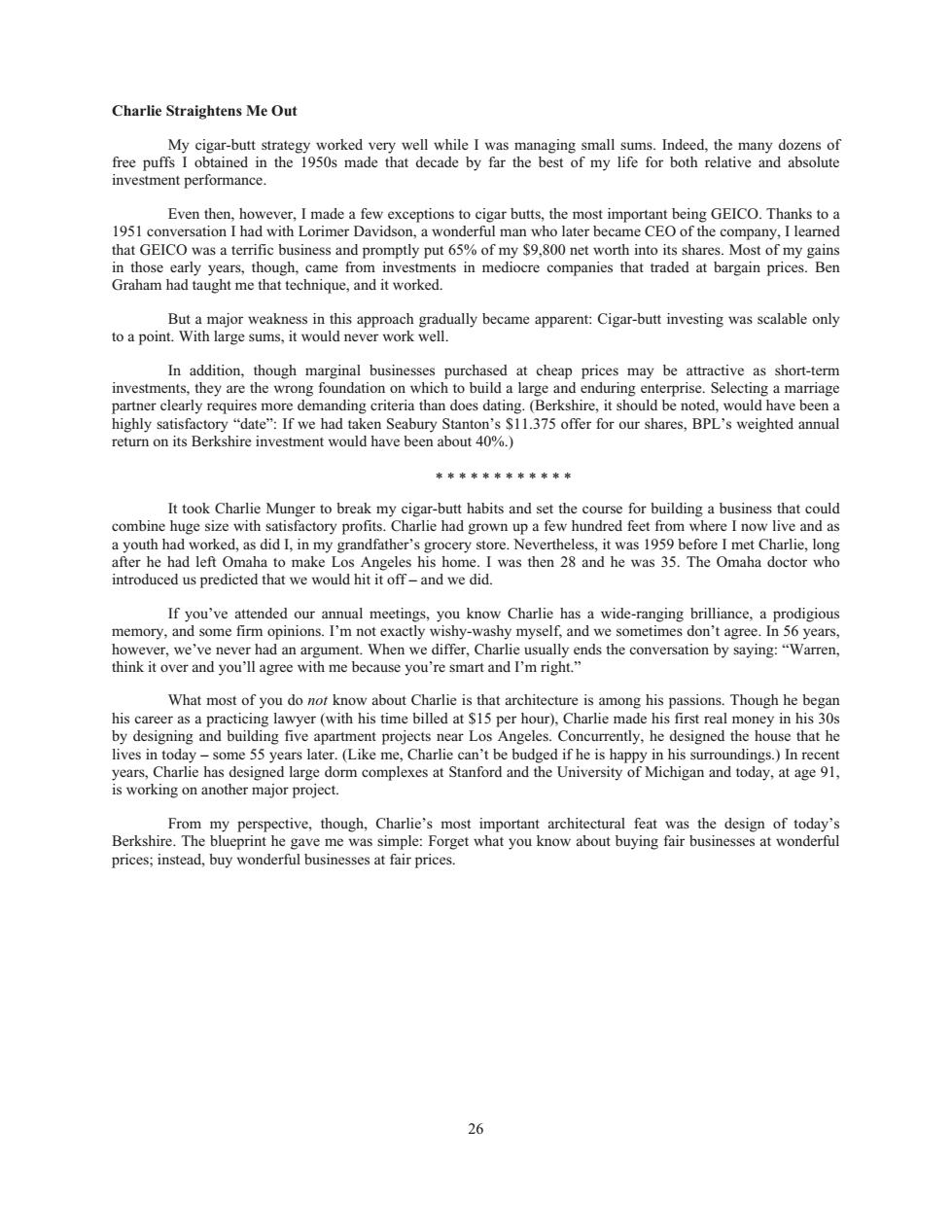正在加载图片...

Charlie Straightens Me Out frce punvy cigar-d in theso madey well while was managing small sum nded. that decade by far the best of my life for both relative and a GIemveme medioere companies tha taded argin price en adually became apparent:Cigar-butt investing was scalable only In additi artner clearly require 高 .375 offer for our shares,BPL's weighted annua a youth had worked,as did in my y pl ndfather's s to make was then 28 and he was 35.The Omaha doctor whe If you'vedurtings you kow Charlie haswid-ranging think it over and you'll agree with me because you're smart and I'm right. What most of you do not know about Charlie is that architecture is among his passions.Though he began his career as vyer (with his time billed at $15 per hour).Charlie made hisf money in his lives in oan e 55 in his sur dings In rec 236Charlie Straightens Me Out My cigar-butt strategy worked very well while I was managing small sums. Indeed, the many dozens of free puffs I obtained in the 1950s made that decade by far the best of my life for both relative and absolute investment performance. Even then, however, I made a few exceptions to cigar butts, the most important being GEICO. Thanks to a 1951 conversation I had with Lorimer Davidson, a wonderful man who later became CEO of the company, I learned that GEICO was a terrific business and promptly put 65% of my $9,800 net worth into its shares. Most of my gains in those early years, though, came from investments in mediocre companies that traded at bargain prices. Ben Graham had taught me that technique, and it worked. But a major weakness in this approach gradually became apparent: Cigar-butt investing was scalable only to a point. With large sums, it would never work well. In addition, though marginal businesses purchased at cheap prices may be attractive as short-term investments, they are the wrong foundation on which to build a large and enduring enterprise. Selecting a marriage partner clearly requires more demanding criteria than does dating. (Berkshire, it should be noted, would have been a highly satisfactory “date”: If we had taken Seabury Stanton’s $11.375 offer for our shares, BPL’s weighted annual return on its Berkshire investment would have been about 40%.) ************ It took Charlie Munger to break my cigar-butt habits and set the course for building a business that could combine huge size with satisfactory profits. Charlie had grown up a few hundred feet from where I now live and as a youth had worked, as did I, in my grandfather’s grocery store. Nevertheless, it was 1959 before I met Charlie, long after he had left Omaha to make Los Angeles his home. I was then 28 and he was 35. The Omaha doctor who introduced us predicted that we would hit it off – and we did. If you’ve attended our annual meetings, you know Charlie has a wide-ranging brilliance, a prodigious memory, and some firm opinions. I’m not exactly wishy-washy myself, and we sometimes don’t agree. In 56 years, however, we’ve never had an argument. When we differ, Charlie usually ends the conversation by saying: “Warren, think it over and you’ll agree with me because you’re smart and I’m right.” What most of you do not know about Charlie is that architecture is among his passions. Though he began his career as a practicing lawyer (with his time billed at $15 per hour), Charlie made his first real money in his 30s by designing and building five apartment projects near Los Angeles. Concurrently, he designed the house that he lives in today – some 55 years later. (Like me, Charlie can’t be budged if he is happy in his surroundings.) In recent years, Charlie has designed large dorm complexes at Stanford and the University of Michigan and today, at age 91, is working on another major project. From my perspective, though, Charlie’s most important architectural feat was the design of today’s Berkshire. The blueprint he gave me was simple: Forget what you know about buying fair businesses at wonderful prices; instead, buy wonderful businesses at fair prices. 26